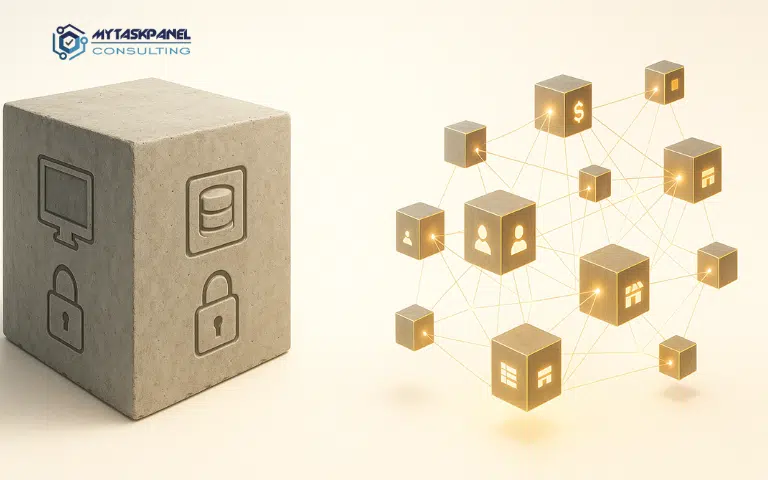In the world of software development, the architecture of an application can determine its long-term success or failure. One of today’s most relevant debates is between microservices and monoliths—two architectural approaches, each with advantages and disadvantages depending on the type of company and its specific needs. While monoliths have been the standard for decades, microservices have gained popularity in recent years due to their flexibility and scalability. In this article, we’ll break down what each one is, their pros and cons, and how they can benefit—or hinder—startups and large companies.
What is a monolithic architecture?
A monolithic architecture is a traditional approach where all the functionalities of an application are integrated into a single codebase. This means all components—from the user interface to the database—are part of one deployable unit.
Advantages of monoliths
- Simplicity in development and deployment: since all the code is in one place, it’s easier to develop, test, and deploy.
- Lower operational overhead: there’s no need to manage multiple services, which reduces operational complexity.
- Efficiency for smaller teams: for startups and small businesses, a monolith can be sufficient, as it doesn’t require complex infrastructure.
- Easier debugging: error tracking and debugging are often simpler, as everything runs in the same execution environment.
Disadvantages of monoliths
- Scalability challenges: as an application grows, a monolith can become difficult to manage and update.
- Low technological flexibility: changing one part of the system might require modifying large portions of the code.
- Higher risk of catastrophic failure: a bug in one part of the application can affect the entire platform.
- Longer deployment times: as the codebase grows, deployments can become slower and more complex.
How does a monolithic architecture work?
In a monolithic system, the entire application is structured as a single codebase and executable. This means all modules (such as authentication, payment processing, user management, etc.) are interconnected and operate as a unit.
- Single codebase: all application functions live in one repository.
- Single database: all components access the same database, simplifying data queries.
- Unified deployment: any code change requires redeploying the whole application.
- Direct internal communication: no need for complex communication mechanisms, as everything runs in the same environment.
Imagine a monolithic online store. It would have a single server handling authentication, purchases, payments, and product management all in one codebase. If one part of the system fails, it’s likely the entire store would go down.
What is a microservices architecture?
Microservices architecture splits an application into multiple independent services, each with its own business logic and database. These services communicate with each other via APIs, allowing for greater flexibility and scalability.
Advantages of microservices
- Independent scalability: each service can scale individually based on specific needs.
- Greater technological flexibility: different services can use different technologies and programming languages.
- Faster development and deployment: teams can work in parallel on different microservices without affecting the whole system.
- Improved fault tolerance: a failure in one microservice doesn’t necessarily impact the entire application.
- Easier maintenance: updates can be made to specific services without affecting others.
Disadvantages of microservices
- Higher operational complexity: advanced infrastructure is needed to manage communication and orchestration between services.
- Higher initial costs: implementing microservices from the start can be time- and resource-intensive.
- Latency issues: communication between services adds latency and potential performance issues.
- More complex debugging and monitoring: advanced tools are required to trace issues in a distributed system.
How does a microservices architecture work?
In a microservices system, the application is divided into multiple independent services that communicate via APIs. Each microservice has its own business logic, its own database, and can be deployed independently.
- Independent services: each module (users, payments, orders) is a separate service with its own database.
- API-based communication: microservices interact using protocols like HTTP/REST or asynchronous messaging with Kafka or RabbitMQ.
- Independent deployment and scalability: if more capacity is needed (e.g., in payment processing), only that microservice is scaled.
- Technological flexibility: each microservice can be built using different programming languages and databases, suited to its purpose.
In a microservices-based online store, payments could be handled by a separate service from authentication and product catalog. If the payment service has an issue, the rest of the store can continue functioning, and users can still browse or add items to their cart while the issue is resolved.
Microservices vs. monoliths: which is better for startups and large enterprises?
The choice between microservices and monoliths depends on the company’s size, development stage, and specific needs.
Startups
Startups often benefit from a monolithic architecture in the early stages, as it allows for fast development with less operational complexity. The priority at this stage is to validate the business idea and launch a minimum viable product (MVP) quickly. However, as the startup grows and the product gains traction, migrating to a microservices architecture may become necessary to better handle scalability and software evolution.
Large enterprises
For established companies with complex applications and distributed development teams, microservices are usually a better fit. They allow different teams to work independently on various parts of the system, improving efficiency and scalability. They also facilitate adopting new technologies without affecting the entire system.
Microservices and monoliths: conclusions
The debate between microservices and monoliths doesn’t have a one-size-fits-all answer. While monoliths may be the best choice for early-stage startups due to their simplicity, microservices offer unmatched scalability and flexibility for large enterprises. The key is to evaluate the specific needs of each business and adapt the architecture accordingly. Some companies may start with a monolith and, as they grow, adopt a microservices approach to optimize operations.
If you’re considering transitioning from a monolith to microservices—or vice versa—it’s crucial to have a well-defined strategy to minimize risks and maximize benefits. Each architecture has its time and place, and the right choice depends on factors like budget, development timeline, and scalability needs.

